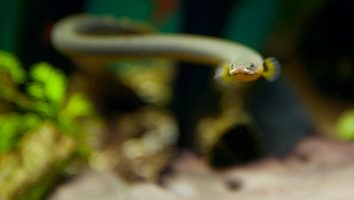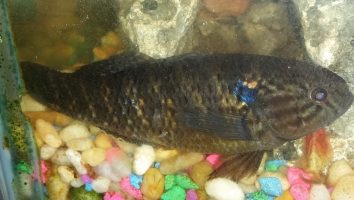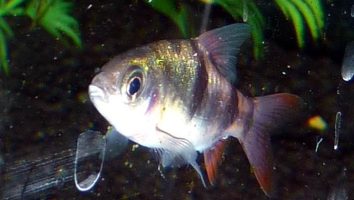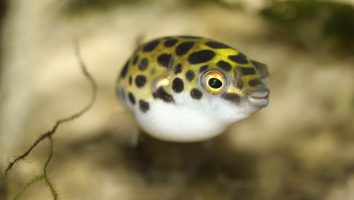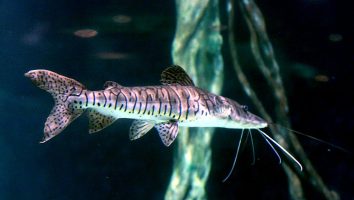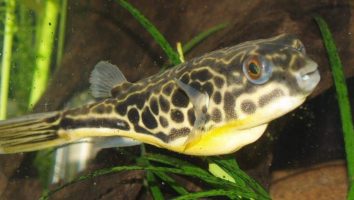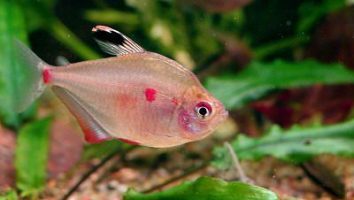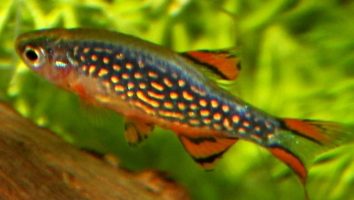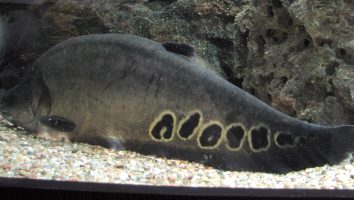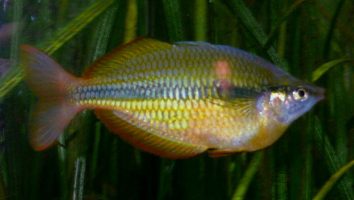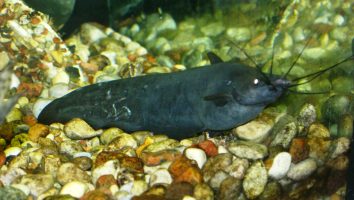The flag cichlid is a beautiful freshwater fish that is perfect for the beginner aquarist. They are relatively easy to care for and are very tolerant of different water conditions.
This guide will teach you everything you need to know about flag cichlid care. You’ll learn about their diet, size, lifespan, and more!
Table of contents
Species overview
The flag cichlid (scientific name: Mesonauta festivus) is a freshwater fish that’s native to various parts of South America. The majority of them can be found in the Amazon Basin, which covers a large area including Peru, Brazil, Colombia, and more.
They prefer slow-moving waters with a lot of vegetation, rocks, and hiding spots. This is something that’s common to many cichlid species since they like to have a lot of places to hide and feel safe.
Flag cichlids are known to be quite peaceful, which is something that’s not always common in the cichlid world. They make great tank mates for other peaceful fish and can even do well with some species of shrimp.
These fish are named for their unique coloration, which is a mix of black, white, and yellow. This pattern is what gives them their “flag” name and is something that many aquarium hobbyists find quite beautiful.
Appearance
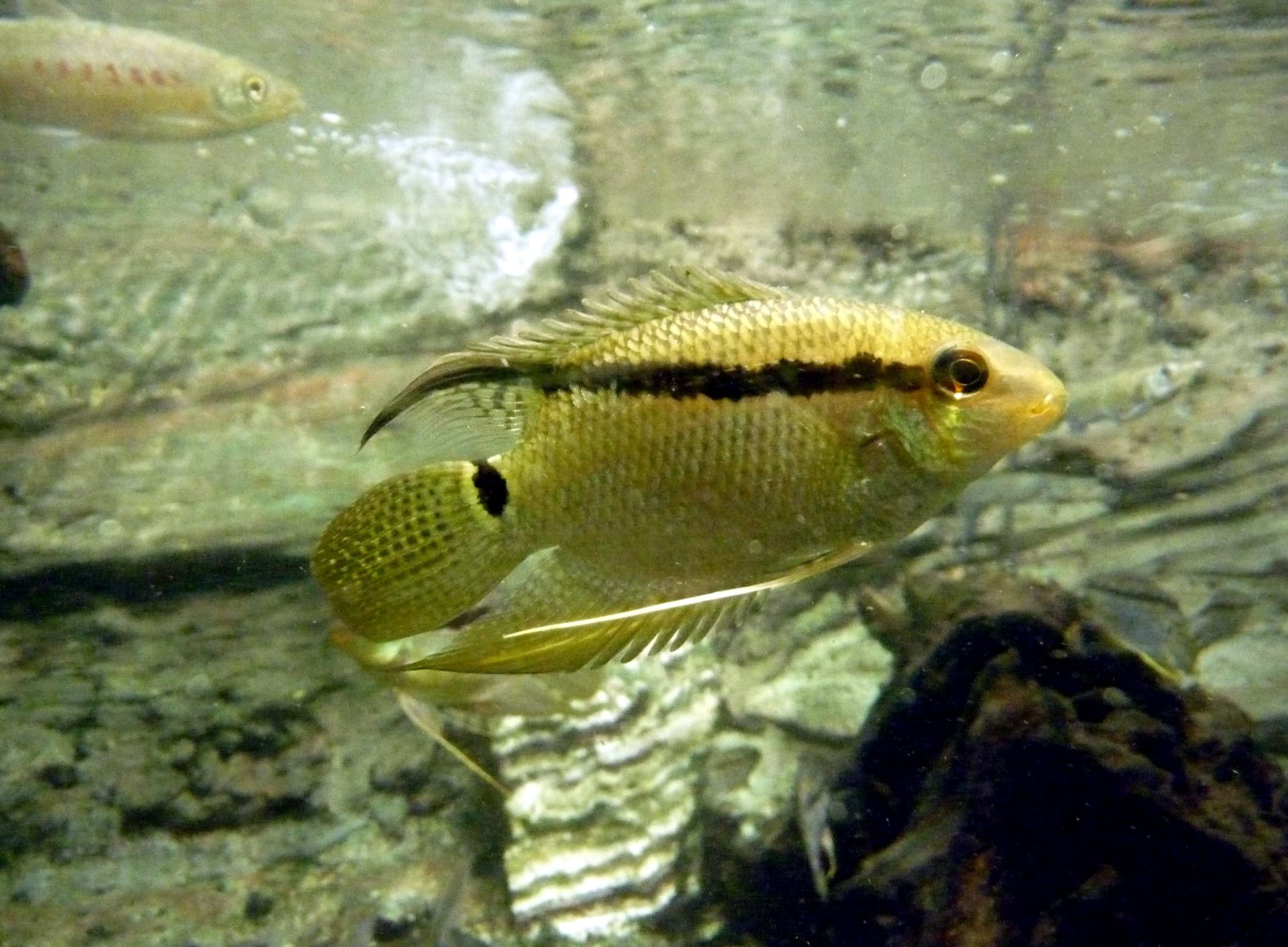
The Flag cichlid is a beautiful freshwater fish that is easily recognizable thanks to its patterning.
The body of the fish is a dark gray or black. This color is broken up by a series of vertical white stripes that run from the gills all the way down to the base of the tail.
The number of stripes can vary from fish to fish, but they typically have around 5-7. The spacing between the stripes is also variable.
The fins on the Flag cichlid are mostly clear with a bit of black along the edges. The dorsal and anal fins are tall and pointy.
The caudal fin is forked and extends outwards quite a bit. The pectoral fins are a bit shorter and sit close to the body.
The face of the Flag cichlid is where things get really interesting. They have large eyes that sit on the top of their head.
Their mouths are located on the bottom of their face and are quite large. This placement allows them to easily vacuum up food from the substrate.
They also have a series of barbels around their mouths that they use to help them find food.
Lifespan
The average lifespan of a flag cichlid is around 10 years. However, there are a number of factors that can impact their life expectancy.
For instance, if they’re not kept in optimal conditions then their lifespan will be shorter. Poor water quality, lack of food, or stress from bad tank mates can all lead to an early death.
On the other hand, if they’re well cared for then they can easily live past 10 years. In fact, it’s not uncommon for flag cichlids to live 15 years or more in captivity.
Size
The average Flag cichlid size is around 6 to 8 inches, with some getting as big as 10 inches. Females are typically a bit smaller than males, but both genders can reach the upper end of this size range under the right conditions.
Tank
Tank Size
The recommended minimum tank size for flag cichlids is 50 gallons. This is assuming you’re keeping them in a school of at least 5 or 6 fish (which you should).
We personally recommend a slightly larger tank if you can accommodate it. Every extra space will make a big difference and allow you to keep a larger school or more tank mates if you’re interested in a community tank.
Water Parameters
The flag cichlid is a tropical fish that requires warm water and a slightly acidic to neutral pH.
They’re also pretty hardy fish, so you don’t have to be too precise with the water parameters. As long as you stay within the ranges below, your flag cichlid should do just fine.
One thing to keep in mind is that flag cichlids are aggressive. They’re not the best community fish and can be a bit of a bully.
You might want to consider setting up a cichlid-only tank if you plan to keep one of these fish. That way, you don’t have to worry about compatibility issues.
Here are a few basic water parameters to help create a healthy flag cichlid environment.
- Water temperature: 75 to 86 degrees Fahrenheit
- pH levels: 6.8 to 7.8
- Water hardness: 8 to 30 dGH
- Alkalinity Levels: 4 to 8 dKH
What To Put In Their Tank
When it comes to decorating the inside of their tank there are a few key things you should include.
First and foremost, these fish love to dig. They’ll do it whether there’s anything in the way or not. It’s best to have a substrate that’s on the softer side to help prevent any cuts or scrapes.
Second, these fish are known to be quite destructive. It’s not uncommon for them to uproot plants or knock over decorations. For that reason, we recommend avoiding anything that’s too delicate.
Instead, go with something like driftwood or rocks. These will provide some enrichment for your fish while also being able to handle some abuse.
Third, these fish love to hide. They’re not the most social creatures so you’ll want to provide them with plenty of places to escape to. Driftwood, rocks, and caves are all great options.
Again, avoid anything too delicate since it’s likely to get destroyed.
And that’s about it! These are just a few of the things we recommend having in a tank with a Flag cichlid. Obviously, you can get creative and add whatever else you want. Just keep the above things in mind and you’ll be fine.
Common Diseases
The Flag cichlid is a pretty hardy fish, but that doesn’t mean they can’t get sick. There are a few diseases that you should look out for, the most common being ich.
Ich is a pretty common disease in freshwater fish, and the Flag cichlid is no exception. It’s caused by a parasite that attaches itself to the fish and begins to feed off of them. The most obvious sign of ich is the presence of white spots on the body of the fish.
If you notice these spots, it’s important to take action immediately. The sooner you begin treatment, the better the chances are that your fish will make a full recovery.
Another disease to look out for is swim bladder disease. This is a bit less common, but it can still affect your fish if they’re not in good water conditions. The most obvious symptom of this disease is a fish that has trouble swimming properly.
If you notice your fish swimming in an abnormal way, it’s important to take a close look at the water conditions in their tank. Improving the quality of the water is usually all it takes to cure swim bladder disease.
Behavior & Temperament
The flag cichlid is a beautiful fish that is known for being somewhat aggressive. They are not the most aggressive cichlids, but they are not the least aggressive either. In general, they are peaceful fish that will only become aggressive if they feel threatened.
One of the reasons they may become aggressive is if they feel like their territory is being invaded. They are very territorial fish, and they will defend their territory to the death if necessary.
Another reason they may become aggressive is if they feel like their mate is being threatened. They are very protective of their mates, and they will do everything they can to defend them.
The last reason they may become aggressive is if they are hungry. They are not afraid to attack other fish in order to get food.
In general, the flag cichlid is a beautiful fish that is relatively peaceful. However, they can become aggressive if they feel threatened.
Tank Mates
The flag cichlid is a beautiful but feisty fish. It’s not recommended for beginners, and even experienced aquarists might have trouble finding appropriate tank mates.
This is because the flag cichlid is both aggressive and territorial. It’s also known to be a bit of a bully, especially when it comes to smaller fish.
With that said, there are a few species that can hold their own against a flag cichlid. These fish are typically large, aggressive, and not afraid to stand up for themselves.
Some potential flag cichlid tank mates include:
- Oscar
- Convict Cichlid
- Jack Dempsey
- Green Terror
- Firemouth Cichlid
- Blood Parrot Cichlid
- Texas Cichlid
Breeding
The flag cichlid is a beautiful and popular fish that is relatively easy to breed in captivity. These fish are mouthbrooders, which means that the female will carry the eggs and fry in her mouth until they are ready to be released.
To initiate spawning, start by setting up a separate breeding tank. It should be at least 30 gallons and contain plenty of hiding places. You can use rocks, caves, and plants to create a comfortable environment.
Then, add a pair of flag cichlids to the tank. It’s best to have one male and one female, but you can also add two males if you can’t find a female.
Once the fish are in the tank, begin feeding them high-quality foods. Live foods are best, but you can also use frozen or freeze-dried foods.
As the fish start to mature, the males will become more aggressive. They will start to chase the females and establish their territories. When this happens, the females will start to lay their eggs.
The female will lay her eggs on a flat surface, such as a rock or piece of driftwood. Once she has laid the eggs, the male will fertilize them. Then, the female will pick them up in her mouth and carry them around.
The fry will stay in the female’s mouth for around three weeks. During that time, she will not eat. After three weeks, the fry will be released and ready to start feeding on their own.
You can feed them live foods, such as brine shrimp or daphnia. You can also use finely-ground flake food.
Conclusion
The Flag cichlid is a beautiful and unique fish that is sure to add some excitement to your tank.
They are relatively easy to care for but do require some specific conditions in order to thrive.
With a little bit of knowledge and preparation, you can create a happy and healthy home for your Flag cichlid.
We hope you’ve enjoyed learning about this amazing fish and we wish you the best of luck with your new pet!

